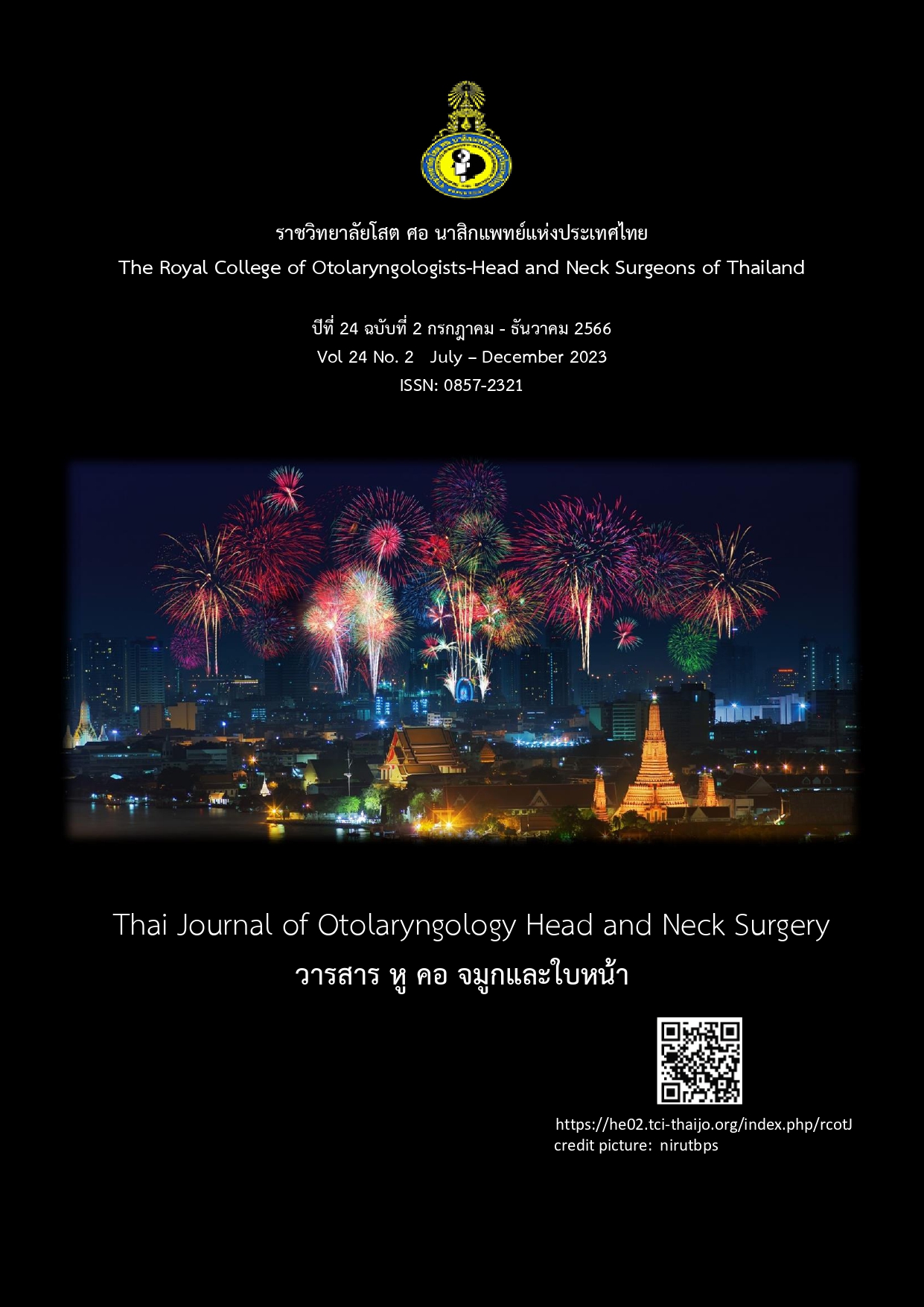Validation of using 2-item and 5-item of the Dizziness Handicap Inventory Thai version for screening Benign Paroxysmal Positional Vertigo (BPPV) in Thai population
Main Article Content
Abstract
Abstract
Objective: To validate the use of total score, 5-item score, and 2-item score of the Thai version
of the Dizziness Handicap Inventory (DHI-TH) for screening benign paroxysmal positional vertigo
(BPPV) in Thai population.
Study Design: A retrospective electronic medical chart review
Setting: Tertiary care teaching hospital
Patients: A total of 60 electronic medical records of patients who were diagnosed with BPPV at the
vestibular clinic were identified during the period from January 2021 to May 2022. The electronic
medical records of another 60 patients with other vestibular disorders were also reviewed.
Main Outcome Measures: The total score, 2-item score, and 5-item score of the DHI-TH were obtained.
Results: The area under the receiver operating characteristic curve (AUC) of the 2-item and 5- item
score for predicting BPPV was 0.855 (95% confidence interval: 0.788-0.923) and 0.806 (95%
confidence interval: 0.728-0.884), respectively. Using a cut-off value of 6 in the 2-item score had
a good sensitivity of 73.33%, specificity of 80% in discriminating BPPV from those without BPPV.
For the 5-item score, a cut-off value of 15 had 63.33% sensitivity and 90% specificity in
separating BPPV from non-BPPV.
Conclusions: Both 5-item and 2-item scores from the DHI-TH are valid for initial BPPV screening. We
recommend using 2-item score due to its time efficiency, aligning with comparable
sensitivity and specificity observed in the 5-item score.
Keywords: Benign paroxysmal positional vertigo—Dizziness—Screening—Dizziness Handicap
Inventory
Article Details

This work is licensed under a Creative Commons Attribution-NonCommercial-NoDerivatives 4.0 International License.
ต้นฉบับที่ส่งมาพิจารณายังวารสารหู คอ จมูก และใบหน้า จะต้องไม่อยู่ในการพิจารณาของวารสารอื่น ในขณะเดียวกันต้นฉบับที่จะส่งมาจะผ่านการอ่านโดยผู้ทรงคุณวุฒิ หากมีการวิจารณ์หรือแก้ไขจะส่งกลับไปให้ผู้เขียนตรวจสอบแก้ไขอีกครั้ง ต้นฉบับที่ผ่านการพิจารณาให้ลงตีพิมพ์ถือเป็นสมบัติของวารสารหู คอ จมูกและใบหน้า ไม่อาจนำไปลงตีพิมพ์ที่อื่นโดยไม่ได้รับอนุญาต
ตารางแผนภูมิ รูปภาพ หรือข้อความเกิน 100 คำที่คัดลอกมาจากบทความของผู้อื่น จะต้องมีใบยินยอมจากผู้เขียนหรือผู้ทรงลิขสิทธิ์นั้นๆ และใหร้ะบุกำกับไว้ในเนื้อเรื่องด้วย
References
REFERENCES
Froehling DA, Bowen JM, Mohr DN, et al. The canalith repositioning procedure for the treatment
of benign paroxysmal positional vertigo: a randomized controlled trial. Mayo Clin Proc
;75:695–700.
Schappert SM. National Ambulatory Medical Care Survey: 1989 summary. Vital Health Stat
;13:1–80.
Katsarkas A. Benign paroxysmal positional vertigo (BPPV): Idiopathic versus post-traumatic. Acta
Otolaryngol 1999;119:745–9.
Hanley K, O'Dowd T, Considine N. A systematic review of vertigo in primary care. Br J Gen Pract
;51:666–71.
Neuhauser HK, Lempert T. Vertigo: epidemiologic aspects. Semin Neurol 2009;29:473–81.
Jeong SH, Kim JS, Shin JW, et al. Decreased serum vitamin D in idiopathic benign paroxysmal
positional vertigo. J Neurol 2013;260:832–8.
Cohen HS, Kimball KT, Stewart MG. Benign paroxysmal positional vertigo and comorbid conditions.
ORL J Otorhinolaryngol Relat Spec 2004;66:11–5.
Cakir BO, Ercan I, Cakir ZA, Civelek S, Sayin I, Turgut S. What is the true
incidence of horizontal semicircular canal benign paroxysmal positional vertigo? Otolaryngol Head
Neck Surg 2006;134:451–4.
Parnes LS, Agrawal SK, Atlas J. Diagnosis and manage- ment of benign paroxysmal positional
vertigo (BPPV). CMAJ. 2003;169:681-693.
Lopez-Escamez JA, Gamiz MJ, Fernandez-Perez A, et al. Long-term outcome and health-related
quality of life in benign paroxysmal positional vertigo. Eur Arch Otorhinolaryngol.
;262:507-511.
Lynn S, Pool A, Rose D, Brey R, Suman V. Randomized trial of the canalith repositioning
procedure. Otolaryngol Head Neck Surg 1995;113:712–20.
Burton MJ, Eby TL, Rosenfeld RM. Extracts from the Cochrane Library: modifications of the Epley
(canalith repositioning) maneuver for posterior canal benign paroxysmal positional vertigo.
Otolaryngol Head Neck Surg 2012;147:407–11.
Hilton MP, Pinder DK. The Epley (canalith repositioning) manoeuvre for benign paroxysmal
positional vertigo. Cochrane Database Syst Rev 2014:CD003162.
Furman JM, Cass SP. Benign
paroxysmal positional vertigo. N Engl J Med 1999;341:1590–6.
Dix MR, Hallpike CS. The pathology, symptomatology and diagnosis of certain common disorders of
the vestibular system. Ann Otol Rhinol Laryngol 1952;61:987–1016.
Casani AP, Nacci A, Dallan I, et al. Horizontal semicircular canal benign paroxysmal positional
vertigo: effectiveness of two different methods of treatment. Audiol Neurootol 2011;16:175–84.
Fife TD. Positional dizziness. Continuum (Minneap Minn) 2012;18:1060–85.
Nuti D, Agus G, Barbieri MT, Passali D. The management of horizontal- canal paroxysmal
positional vertigo. Acta Otolaryngol 1998;118:455–60.
Honrubia V, Baloh RW, Harris MR, Jacobson KM. Paroxysmal positional vertigo syndrome. Am J Otol
;20:465–70.
White JA, Coale KD, Catalano PJ, Oas JG. Diagnosis and management of lateral semicircular canal
benign paroxysmal positional vertigo. Otolaryngol Head Neck Surg 2005;133:278–84.
Jacobson GP, Newman CW. The development of the Dizziness
Handicap Inventory. Arch Otolaryngol Head Neck Surg 1990;116:424–7.
Whitney SL, Marchetti GF, Morris LO. Usefulness of the dizziness handicap inventory in the
screening for benign paroxysmal positional vertigo. Otol Neurotol 2005;26:1027–33.
Chen W, Shu L, Wang Q, et al. Validation of 5-item and 2-item questionnaires in Chinese version
of Dizziness Handicap Inventory for screening objective benign paroxysmal positional vertigo.
Neurol Sci 2016;37:1241–6.
Saxena A, Prabhakar MC. Performance of DHI score as a predictor of benign paroxysmal positional
vertigo in geriatric patients with dizziness/vertigo: a cross- sectional study. PLoS One
;8:e58106.doi:10.1371/journal.po ne.0058106.
Emasithi A, Pakdee S, Isaradisaikul SK, Uthaikhup S. Translation and validation of the
Dizziness Handicap Inventory into Thai language. Otol Neurotol 2022;43:e252–8.
Mahasitthiwat V. Dizziness Handicap Inventory Scores in Aiding the Diagnosis between Horizontal
and Posterior Canal Benign Paroxysmal positional Vertigo. J Med Assoc Thai
;101:1437-42.
Korres S, Balatsouras DG, Kaberos A, Economou C, Kandiloros D, Ferekidis
E. Occurrence of semicircular canal involvement in benign paroxysmal positional vertigo. Otol
Neurotol 2002;23:926–
Caruso G, Nuti D. Epidemiological Data from 2270 PPV patients. Audiol Med 2005;3:7–11.
Soto-Varela A, Santos-Perez S, Rossi- Izquierdo M, Sanchez-Sellero I. Are
the three canals equally susceptible to benign paroxysmal positional vertigo? Audiol Neurootol
;18:327–34.
Lindell E, Karlsson T, Johansson M, Magnusson M, Finizia C. Investigation of self-reported
dizziness in the elderly when lying down or turning over in bed, and possible benign paroxysmal
positional vertigo. J Laryngol Otol 2019;133:275–80.

